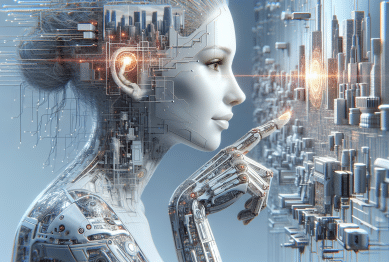Quantum computing sparks curiosity for its potential to radically transform problem-solving in tech and science. This guide makes sense of how it works, where it’s headed, and what sets it apart from classical computing—all in a way that’s easy to understand, even if you’re just starting to explore quantum advancements.
Understanding Quantum Computing and Its Appeal
Quantum computing frequently appears in discussions about the future of technology, and for good reason. The approach relies on qubits, which are the building blocks of quantum computers and are fundamentally different from binary bits used in traditional systems. Qubits can hold both a 0 and a 1 simultaneously, thanks to principles of superposition—a core concept in quantum physics. This dual state allows quantum computers to process calculations at speeds impossible for classical computers, particularly when handling massive, complex datasets. This creates huge interest in quantum computing among researchers, tech companies, and those curious about what comes next in data analysis and modeling.
The superposition property isn’t the only quantum phenomenon at play; quantum entanglement also gives these machines their unique edge. Entanglement means that the state of one qubit is directly related to another, no matter how far apart they are. This lets quantum computers manage parallel data streams like nothing else, reducing the time it takes to solve specific advanced problems. Emerging uses for quantum computing include cryptography, material discovery, and advancing machine learning models. For those following this tech, it’s clear that its potential feels vast.
One compelling reason quantum technologies captivate attention is that they promise to unlock solutions to challenges considered intractable for decades. Simulating molecules for new medicines, verifying cybersecurity systems, or predicting rare events in climate science—these are just a few ways quantum computing may deliver game-changing results. With government, academia, and private industry all investing, the interest isn’t fleeting. Curiosity about quantum computing isn’t just hype; it’s founded on real advances and robust, ongoing research that continues to surprise those enthusiastic about technical discovery.
The Key Differences Between Quantum and Classical Computers
Most people are familiar with classical computers—their laptops and phones—which use bits to represent information. Each bit stands for either a 0 or a 1, processing data step by step. Quantum computers, however, make use of qubits, which take advantage of quantum mechanics to exist in multiple states at once. This enables them to solve intricate problems much faster, making them ideal for work like complex simulations and optimization.
Classical computers excel at general computation and perform well for most current applications. However, when a situation calls for processing combinations that exceed classical capabilities, quantum computers become an exciting alternative. Tasks such as rapidly searching large datasets or simulating molecular behaviors—critical in areas like chemical engineering—showcase how quantum-based approaches can change what’s possible in research and practice.
The hardware structure also differs significantly. While classical machines rely on integrated circuits and silicon chips, quantum systems often operate at temperatures near absolute zero to preserve qubit integrity. Many use superconducting circuits or trapped-ion technologies to store and manipulate quantum data. Despite their complexity, these platforms point to a future in which quantum-enabled solutions become accessible to many fields, not just specialized scientific labs.
Quantum Superposition and Entanglement: The Source of Computing Power
Central to the marvel of quantum computers is quantum superposition. This concept means that a single qubit can embody multiple possibilities at once, rather than just a 0 or a 1. As a result, each added qubit effectively doubles a quantum computer’s processing potential. When algorithms exploit this feature, they achieve results that would otherwise take years on traditional machines—a leap that fascinates those interested in computation and science alike.
Equally powerful is quantum entanglement—the phenomenon where two or more qubits link in such a way that the state of one instantly influences the state of the other, even at a distance. This property gives quantum computers their profound connectivity and allows calculations to scale exponentially. Entanglement enables new types of encryption and communication protocols, which researchers are actively exploring to enhance cybersecurity and error correction in digital transmission.
Combining superposition and entanglement allows quantum devices to perform parallel operations across a web of possible results. These intertwined features drive enthusiasm in the quantum sector, with experimental devices routinely surpassing classical benchmarks in prototype tests. The steady improvement in controlling and measuring qubits means a broader spectrum of users may soon benefit from these fundamental scientific insights, fueling the quantum imagination globally.
Promising Uses: From Cryptography to Pharmaceuticals
The unprecedented computational might of quantum systems opens new frontiers, especially in cryptography. Traditional encryption methods—relying on the difficulty of factoring large numbers—could be cracked in seconds by sufficiently advanced quantum machines. This possibility drives both excitement and concern, pushing researchers to develop quantum-resistant algorithms and more robust security measures, expanding the fields of cybersecurity and privacy protection.
Quantum computing also shows transformative promise in materials science and pharmaceuticals. Simulating the behavior of molecules and materials at quantum scale, something that would overwhelm a classical supercomputer, is becoming feasible as quantum algorithms progress. This breakthrough may lead to discovering new drugs, energy storage technologies, and sustainable chemistry solutions. The efficiency of quantum simulations presents a potential leap forward in product development cycles and scientific discovery.
Optimization problems, common across logistics, finance, and engineering, are another area where quantum approaches can outperform conventional ones. For example, finding the best route for delivery trucks, maximizing portfolio performance, or designing resilient networks takes weeks of computation with classic technology. Quantum computers, when fully realized, may deliver results in a fraction of the time, saving resources and fostering new economic opportunities for those able to harness their potential.
Current Challenges in Quantum Computing Research
While the promise of quantum computing draws intense interest, significant physical and engineering challenges remain. Qubits are highly sensitive to their environment and must be isolated from noise and heat. Maintaining quantum coherence—the delicate state where a qubit remains operational—requires sophisticated cooling systems and error correction protocols. Many leading labs globally are working to overcome these barriers, seeking more stable and scalable architectures that can move quantum technology from the lab to practical deployment.
Another major hurdle is error correction. Unlike classical bits, qubits are susceptible to a range of errors, from external interference to minute fluctuations in electromagnetic fields. Creating redundancy and designing logical qubits that self-correct is a fast-evolving field. Research on these issues is as crucial as advances in qubit count or computational speed since reliability is a must for quantum technology to find mainstream use.
Resource-demanding technology is not the only challenge. Quantum algorithms are complex, requiring new ways of thinking for programmers and scientists. The ecosystem supporting quantum hardware and software is still maturing, meaning few professionals have practical, hands-on experience. Educational initiatives are expanding to bridge this gap, preparing the next wave of scientists, engineers, and curious explorers for a future where quantum computing shapes discovery and innovation across many disciplines.
The Future Outlook: Integration with Artificial Intelligence and Data Science
Combining quantum computing and artificial intelligence (AI) opens new avenues for both fields. Quantum systems could optimize neural network training—reducing time to insights and making predictive analytics more powerful. Machine learning models, particularly those dealing with complicated, high-dimensional data, could see breakthroughs once they run on quantum hardware. The interplay between quantum and AI may define the next major step in information technology evolution.
In data science, quantum computing may allow for rapid analysis of massive data sets—from genomics to environmental modeling. The impact may be particularly strong in areas involving pattern recognition, optimization, and simulation. Already, several organizations are providing access to cloud-based quantum computers, encouraging experimentation and broadening the scope of possible use cases as researchers refine their quantum workflow strategies.
As development continues, the integration of quantum resources with conventional information systems is expected to become seamless. Cloud-based access will help companies and universities explore hybrid solutions that combine classical and quantum processing—accelerating discovery without demanding expertise in quantum hardware. As more users engage, the sector anticipates network effects—faster progress, wider adoption, and surprising developments at the intersection of quantum computing and everyday technology.
References
1. National Institute of Standards and Technology. (n.d.). What is Quantum Computing? Retrieved from https://www.nist.gov/pml/quantum-physics/quantum-computing
2. IBM Research. (n.d.). Quantum Computing Explained. Retrieved from https://research.ibm.com/quantum-computing/
3. Massachusetts Institute of Technology. (n.d.). Quantum Computing for the Determined. Retrieved from https://ocw.mit.edu/courses/6-s089-quantum-computing-for-the-determined-january-iap-2018/
4. European Quantum Flagship Initiative. (n.d.). Applications of Quantum Computing. Retrieved from https://qt.eu/about-quantum-technology/quantum-computing/
5. U.S. Department of Energy. (n.d.). The Promise of Quantum Computing. Retrieved from https://www.energy.gov/science/doe-explainsthe-promise-of-quantum-computing
6. Association for Computing Machinery. (n.d.). Quantum Computing: Progress and Prospects. Retrieved from https://www.acm.org/articles/quantum-computing-progress-and-prospects









